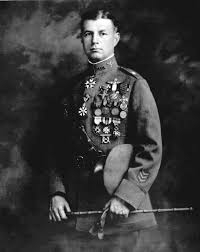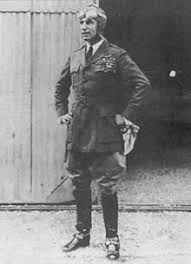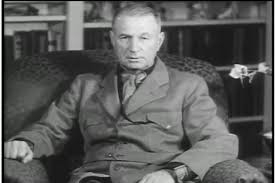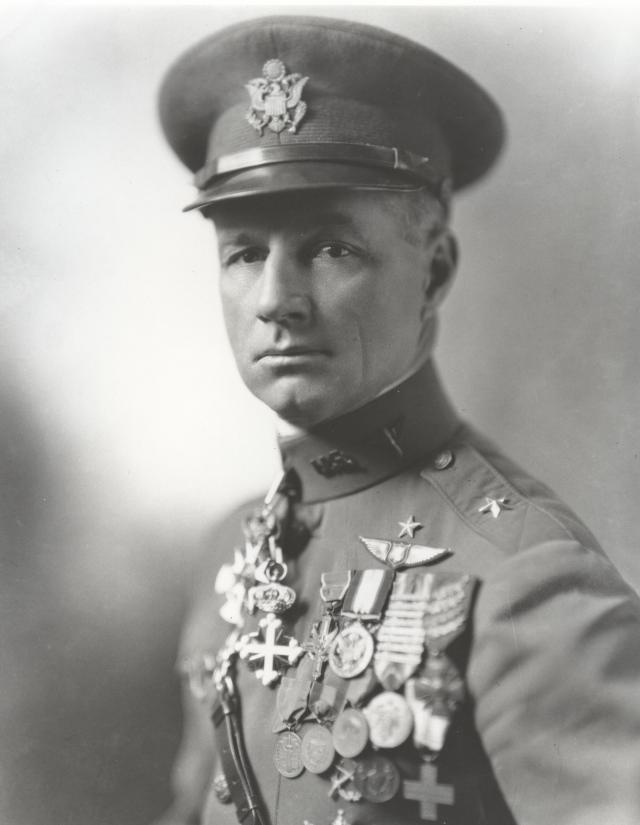Mitchell as Assistant Chief of Air Service (in non-regulation uniform)
Born in Nice, France to John L. Mitchell, a wealthy Wisconsin senator and his wife Harriet, Mitchell grew up on an estate in what is now the Milwaukee suburb of West Allis, Wisconsin. His grandfather, Alexander Mitchell, a Scotsman, established what became the Milwaukee Road railroad and the Marine Bank of Wisconsin. Mitchell Park and the shopping precinct of Mitchell Street were named in honor of Alexander. Mitchell's sister Ruth fought with the Chetniks in Yugoslavia during World War II and later wrote a book about her brother, My Brother Bill.
Following the cessation of hostilities, Mitchell remained in the Army. From 1900 to 1904, Mitchell was posted in the District of Alaska as a lieutenant in the Signal Corps. On May 26, 1900, the United States Congress appropriated $450,000 in order to establish a communications system to connect the many isolated and widely separated U.S. Army outposts and civilian Gold Rush camps in Alaska by telegraph. Along with Captain George C. Brunnell, Lieutenant Mitchell oversaw the construction of what became known as the Washington-Alaska Military Cable and Telegraph System (WAMCATS). He predicted as early as 1906, while an instructor at the Army's Signal School in Fort Leavenworth, Kansas, that future conflicts would take place in the air, not on the ground.
A member of one of Milwaukee's most prominent families, Billy Mitchell was probably the first person with ties to Wisconsin to see the Wright Brothers plane fly. In 1908, when a young Signal Corps officer, Mitchell observed Orville Wright's flying demonstration at Fort Myer, Virginia. Mitchell took flight lessons at the Curtiss Aviation School at Newport News, Virginia.
He then enlisted as a private at age 18 in Company M of the 1st Wisconsin Infantry Regiment on May 14, 1898, early in the Spanish–American War. Quickly gaining a commission due to his father's influence, he joined the U.S. Army Signal Corps.
In March 1912, after assignments in the Philippines that saw him tour battlefields of the Russo-Japanese War and conclude that war with Japan was inevitable one day, Mitchell was one of 21 officers selected to serve on the General Staff—at the time, its youngest member at age 32. He appeared in August 1913 at legislative hearings considering a bill to make Army aviation a branch separate from the Signal Corps and testified against the bill. As the only Signal Corps officer on the General Staff, he was chosen as temporary head of the Aviation Section, U.S. Signal Corps, a predecessor of the present day United States Air Force, in May 1916, when its head was reprimanded and relieved of duty for malfeasance in the section. Mitchell administered the section until the new head, Lieutenant Colonel George O. Squier, arrived from attaché duties in London, England, where World War I was in progress, then became his permanent assistant. In June, he took private flying lessons at the Curtiss Flying School because he was proscribed by law from aviator training by age and rank, at an expense to himself of $1,470 (approximately $33,000 in 2015). In July 1916, he was promoted to major and appointed Chief of the Air Service of the First Army.
World War I
The French-built SPAD XVI which Mitchell piloted in the war, now exhibited inside the National Air and Space Museum in Washington, D. C. The SPAD XVI, an observation and bomber aircraft, has a Lewis twin machine gun mounted in the rear cockpit.
When the United States declared war on Germany on April 6, 1917, Mitchell was in Spain en route to France as an observer.[4] He arrived in Paris on April 10, and set up an office for the Aviation Section from which he collaborated extensively with British and French air leaders such as General Hugh Trenchard, studying their strategies as well as their aircraft. On April 24, he made the first flight by an American officer over German lines, flying with a French pilot. Before long, Mitchell had gained enough experience to begin preparations for American air operations. Mitchell rapidly earned a reputation as a daring, flamboyant, and tireless leader. In May, he was promoted to lieutenant colonel. He was promoted to the temporary rank of colonel on October 10, 1917, to rank from August 5.
In September 1918, he planned and led nearly 1,500 British, French, and Italian aircraft in the air phase of the Battle of Saint-Mihiel, one of the first coordinated air-ground offensives in history. He was elevated to the rank of (temporary) brigadier general on October 14, 1918, and commanded all American air combat units in France. He ended the war as Chief of Air Service, Group of Armies, and became Chief of Air Service, Third Army after the armistice.
Recognized as one of the top American combat airmen of the war alongside aces such as his good friend, Eddie Rickenbacker, he was probably the best-known American in Europe. He was awarded the Distinguished Service Cross, the Distinguished Service Medal, the World War I Victory Medal with eight campaign clasps, and several foreign decorations. Despite his superb leadership and his fine combat record, he alienated many of his superiors during and after his 18 months of service in France.
Post-war advocate of air power
Return from Europe
Billy Mitchell posing with his Vought VE-7 Bluebird aircraft at the Bolling Field Air Tournament (in Washington, D.C.), held on May 14–16, 1920
Billy Mitchell posing with his Thomas-Morse MB-3
Col. Archie Miller, Benedict Crowell, Lt. Ross Kirkpatrick, Sgt. E. N. Bruce, Mitchell
Col. Archie Miller, Benedict Crowell, Lt. Ross Kirkpatrick, Mitchell, Sgt. E.N. Bruce
Mitchell returned to the United States in January 1919; it had been widely expected throughout the Air Service that he would receive the post-war assignment of Director of Air Service. Instead, he returned to find that Maj. Gen. Charles T. Menoher, an artilleryman who had commanded the Rainbow Division in France, had been appointed director on the recommendation of his classmate General Pershing, to maintain operational control of aviation by the ground forces.
Mitchell received appointment on February 28, 1919, as Director of Military Aeronautics, to head the flying component of the Air Service, but that office was in name only as it was a wartime agency that would expire six months after the signing of a peace treaty. Menoher instituted a reorganization of the Air Service based on the divisional system of the AEF, eliminating the DMA as an organization, and Mitchell was assigned as Third Assistant Executive, in charge of the Training and Operations Group, Office of Director of Air Service (ODAS), in April 1919. He maintained his temporary wartime rank of brigadier general until June 18, 1920, when he was reduced to lieutenant colonel, Signal Corps (Menoher was reduced to brigadier general in the same orders).
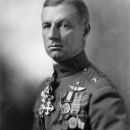
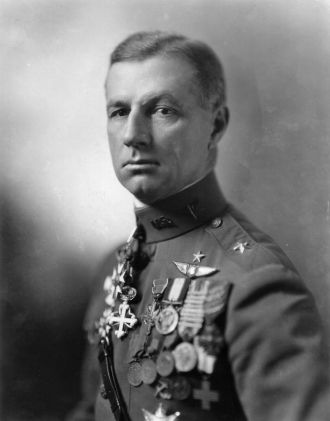
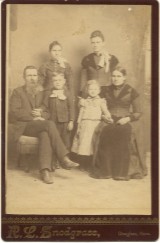
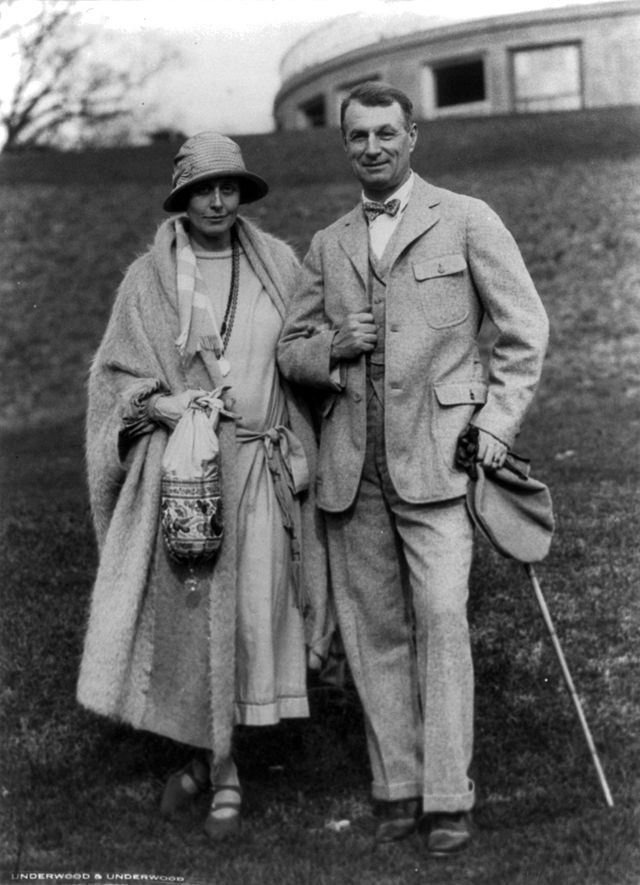
 Amanda S. Stevenson
Amanda S. Stevenson 